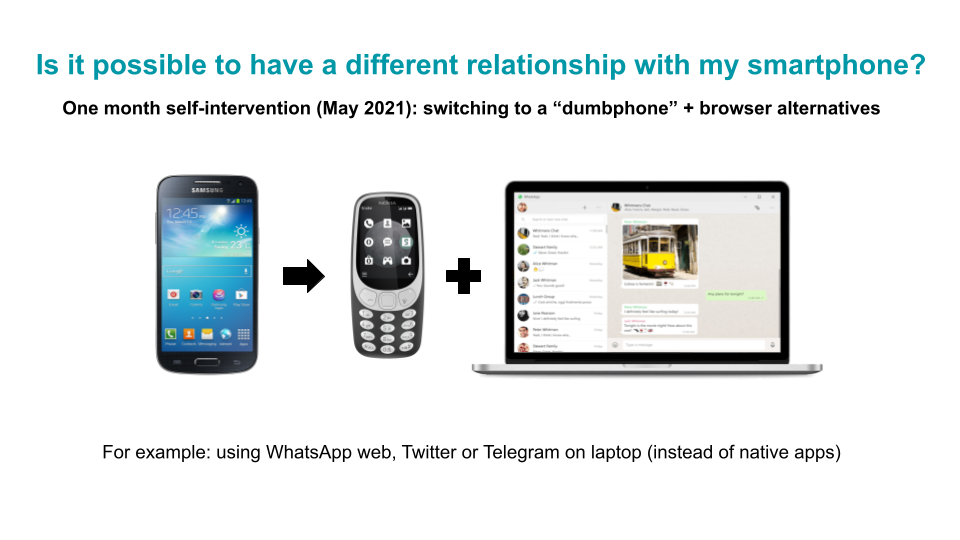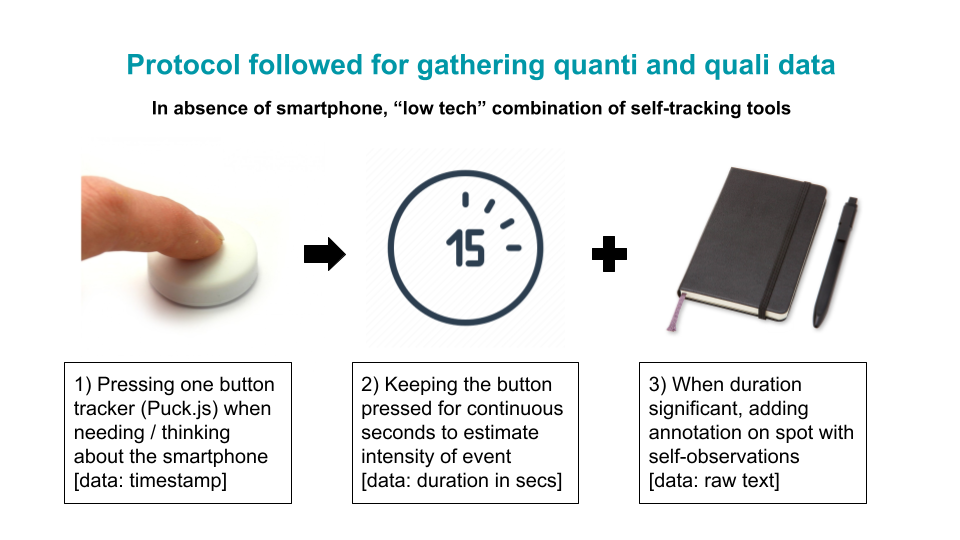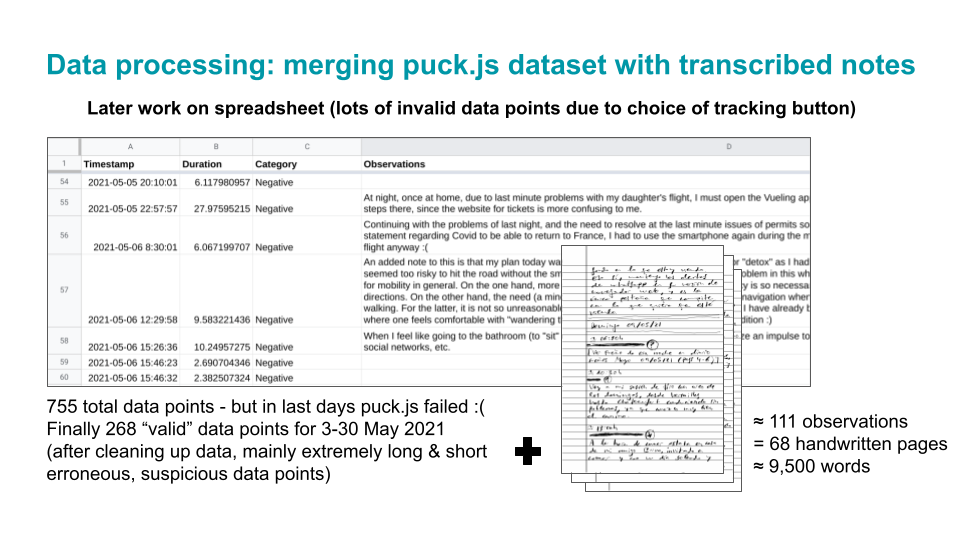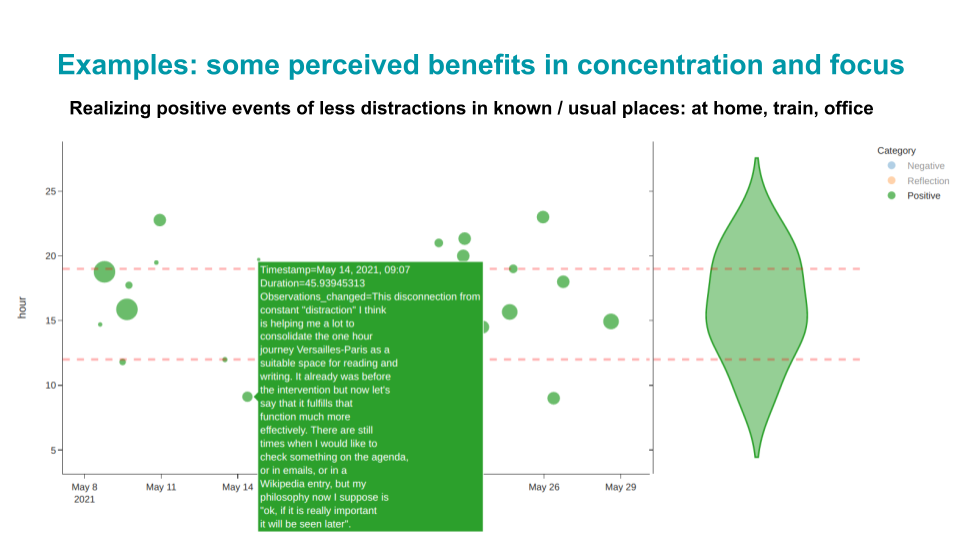Inspired by the concepts of self-experimentation and quantified self, some time ago I decided to re-try something that I had attempted in the past but in a very piecemeal way: put my smartphone aside and instead use a Nokia feature phone or “dumbphone”. Why do something like that? First of all, I must clarify that it is not a question of neo-luddite philosophy or aspiring to a way of life without technology. It is clear that our current lifestyle in “developed” societies cannot be separated from digital tools. And among these disruptive tools, the smartphone is the one that has most penetrated our day-to-day lives, altered our habits and created new ones that are very difficult to detach from.
However, and for that very reason, my starting question for a small autoethnographic experiment was: “Is it possible to have a different relationship with my smartphone?”. Because although I know that there are many advantages and benefits derived from smartphones, I have also felt often and systematically “hooked” to mine, as a kind of addiction linked to my attention – something that I also observe in others, and especially the people with whom I live and share my day to day. I will not elaborate here on the potentially negative effects of the abusive use of the smartphone or other digital media, increasingly studied from different disciplines.You can take a look at this Wikipedia article on problematic smartphone use or at this Zotero folder in which I am compiling articles on the subject that I find interesting.
Or just think about how you use your smartphone, or people around you… It seems that we all have a very obvious case study there, which is worth paying attention to. From my side, I set myself the personal challenge of taking a step back and trying to use a technology prior to those powerful computers that smartphones are today, to experience things first-hand and try to understand with maximum detail the effects of such intense and demanding relationships with the “smart” device. This is, by means of a drastic suppression or deliberate distancing with a technology that has become so intimate and, in principle, necessary. Aware that it is not the only tool at my disposal, my laptop would thus become the device where I could continue to use everything that I could no longer do with the feature phone (that is, beyond phone calls, alarm clock and SMS messages). Luckily for me, most popular apps such as Whatsapp, Google maps or Spotify, etc. almost all have their corresponding versions in specific software programs or through a simple Internet browser. I try to explain this and other things more visually below with some of the images in this post (from the slides of a presentation I gave for the 2nd edition of the Keating Memorial).

Also aware that I could face many practical inconveniences with this radical change in technology use, I decided to limit this first experiment to one month (May 2020) and consider it a self-intervention in wider sense – similar to what is usually done in psychological interventions, where the the short duration of a change in behaviour or pattern can help shed light on a personal or addiction problem, and if it goes well, contribute to deal with it.
And how did I do it? What was, let’s say, my “methodological” approach? First of all, to try to get a detailed account of all my reactions to not having the smartphone with me, I opted for a mini device to track these events as they happened: the “puck”. It is a simple low cost beacon button, which each time is pressed can register the timestamp and the duration of such pressure. This data is recorded locally on the button itself, and can then be downloaded to a computer. It is something easy to carry in your pocket (although as I will explain, that in turn produced some unforeseen problems) and which solved the technical part of obtaining basic quantitative data each time I felt the need or the habit of using the smartphone. Secondly, I decided to use a simple notebook (equally small, that would fit in my pocket) to be able to write down in parallel all the observations and thoughts that arose during the intervention. Anticipating that these annotations were not going to be as many or as frequent as the total number of events recorded with the puck, I considered that I would associate them with those “pressures” of longer duration (and therefore more significant), for which I also wrote down the date and the exact time in my notebook.

That is, when preparing the intervention I had planned a relatively simple and “low tech” protocol that could allow me, on the one hand (simply by pressing a button in my pocket) to register any hint of need or thought related to the change in using a feature phone instead of a smartphone. In addition, depending on the duration of such pressure, I could also get an estimate of the intensity of this or that reaction, thought or situation. On the other hand, for greater detail and a reminder of those most significant events, the notebook would allow me to describe things in greater depth for later analysis, as observations taken “in situ” after pressing the button in occasions that I consider relevant. By also writing the date and time on each note, I would have the possibility (during the processing and analysis of data) to associate the observations in my notebook with the database generated by the puck button.
How did the intervention go? Before summarising the results of this brief but intense process, two cents on how the idea and the devised protocol developed (and varied significantly) once I put it into practice. On the one hand, shortly after starting to move around and trying to get through each day without using the smartphone, I realized the technical impossibility of keeping that substitution to the letter. In let’s say exceptional or force majeure situations, but with relative recurrence, I had to retrieve the smartphone from the corner where it was relegated: due to Zoom meetings that I could not miss (and for which my old Linux laptop was no alternative), urgent Whatsapp video calls or with the family (this option is not available in the web version of the app), some new or complicated car journeys (where driving without Google maps would have meant getting lost for sure, not showing up or being late for an appointment). Despite representing a lower percentage of “concessions”, I also registered these types of events with the puck and wrote down the corresponding observations, so that the data count also incorporates them as “negative” reactions during that month of experimentation.
Another important issue that arose shortly after starting the intervention was that I also began to record events (reactions, consequences, sensations) that were not negative or associated with discomfort, need or concerns, but rather the opposite. These were times when I was aware of not having the smartphone with me and liking it, or paying attention to things that if I had the mobile I would have missed… I also registered them by pressing the button significantly, but in this case adding an annotation or comment in my notebook with the category “positive” in order to distinguish them from “negative” events by default, and that was something not initially foreseen. Also soon after, even a third category was needed (duly registered as such in my notes) which I first named “questions”, and later reclassified with the more generic term “reflections.” This last type of event, regardless of the dichotomy or simplification if you want between “negative / positive”, had to do with questions in which I thought about self-experiment process itself (that is, a kind of “meta” level), and also in relation to more general questions that arose beyond myself. Probably one of the things that influenced me for these more reflective events was starting to read during that month Carl Newport’s book Digital Minimalism (hence the title of this post and the intervention).
One last comment about the process, before moving on to results: after recording events as I have explained, I ended up having a very high volume of data, both quantitative and qualitative (755 button presses, 111 observations that added up to around 9,500 words). Here also a couple of things to highlight, which speak of the complexity (or naivety if you will) of doing something like this for the first time – and of doing it with new and very different tools, whose data then have to be converged. On the one hand, as it sometimes worried me, the puck ended up failing in the very last days of the intervention. After using it as usual (although less frequently, since the volume of negative events was clearly decreasing), the last day of data collection gave me the surprise that the last data points were not there when I tried to download them. This was a relatively minor but annoying incident, and luckily by then I still had a proper list of the last most significant events (that is, those of the longest duration) conveniently noted in my notebook as well, so I was able to “re-create” them on the spreadsheet without further problem. The second technical setback that I suffered, and that I should have anticipated if I had tested the puck button well, is that it was incorrectly recording a significant volume of data without me pressing it voluntarily. This was for a reason as obvious as always carrying it squeezed inside my jeans pocket, next to other objects such as keys, coins or the pheature phone itself. When realising that volume of data about suspicious button presses at the end of the process, not fitting at all with my perception nor memory of the experience, I despaired and almost abandoned the rest of the work. However, luckily I soon realized that it was either extremely short “pressures” (most of a couple of seconds or less, for sure due to bumps, frictions or pressing it by mistake when looking for something else in the pocket), or events of an extremely long duration (literally thousands of seconds, in this case for sure when placing something on top of the button, or in most cases most likely by being seated pressing it involuntarily). After realizing both, and being able to clearly identify the “noise” from these false positives, I just had to perform the tedious but simple task of removing them from the spreadsheet. There’s more detailed info in a QS Forum thread on these implementation issues and the source of problems and solutions (as well as alternatives to the one-button tracker I used).

Well, what about the results finally? Below is a summary of the most interesting things for me after analyzing this self-intervention. For better details, you can check this dynamic visualization to navigate the data, thanks to the invaluable help of @gedankenstuecke.

- Feelings of habit / dependence / addiction were very strong during the first 7-10 days, but then they decreased, while some positive aspects and reflections emerged in parallel. In a way, this is something very similar to what people with addictive behaviors experience (for example when quitting smoking).
- Main negative perceptions, according to my notes and the recorded intensity of events, had to do with technical / practical / usability inconveniences, from non-optimal communication and information retrieval problems to finally having to reach the smartphone in specific situations.
- Another order of significant negative events had to do with how I felt uncomfortable or strange at specific times of the day, from going to the bathroom each morning without my smartphone, to waiting times in public transport, when the acquired habit made me feel uneasy, sometimes even anxious.
- The positive events of the intervention had to do with episodes of “mindfulness” and being aware of living the moment, better appreciating what surrounded me. From “mental photos” of this or that situation to realizing the lack of distractions during various activities, away from the recurring distraction of the smartphone screen.
- The reflections I wrote down in relation to other events had to do with my inexperience and insecurity in the way I was trying to self-experiment (let’s say at a “meta” level), but also in relation to other people. Especially about how they could perceive me when knowing about my choice of phone, or the intervention I was trying out.


Next steps? After concluding a first analysis and let’s say this tentative but rigorous approach to the question of my relationship with the smartphone, I returned to using it regularly as I used to, “letting myself go”. Currently I’m alternating similar periods of dumphone vs. smartphone to be able to then compare data*. To do this, I have added to the protocol an automatic time tracking for software use (Activity Watch), both on my smartphone and on my laptop, which I hope can contribute to clarify two issues over time:
- If I experience any kind of “bounce effect” or increased use of the laptop device when not using the smartphone. I think that is probably the case, but I am interested in analyzing it well beyond my general perception.
- If in the longer term this type of self-intervention leads to some significantly different use of the smartphone – or even a permanent / longer replacement of the feature phone to the detriment of the smartphone.
And there is one more thing … I guess as a sort of bias due to my training in social sciences and “sociological” interest in things, I’m now trying to find out (more and better) what other people think, feel or do in all this regard. So I’m also looking for ways to surround this object of self-research with more data about social and cultural stuff regarding “interacting in another way” with smartphones – including other people if necessary (and possible) in the study.
(*) Regarding this smartphone VS feature phone approach, taking an interesting suggestion via the Digital minimalism reddit I could also use in other periods a kind of “third way” approach, where I keep using the smartphone but in a sort of “extended work mode”. That is, limited to just few options via settings, such that I cannot use all the apps of my choice. My intuition is that I will probably end up changing things there with some regularity, and this way progressively allowing more distractions and disruptions available just at a touch of screen. In any case, I think is compatible with the overall plan, so let’s see 🙂